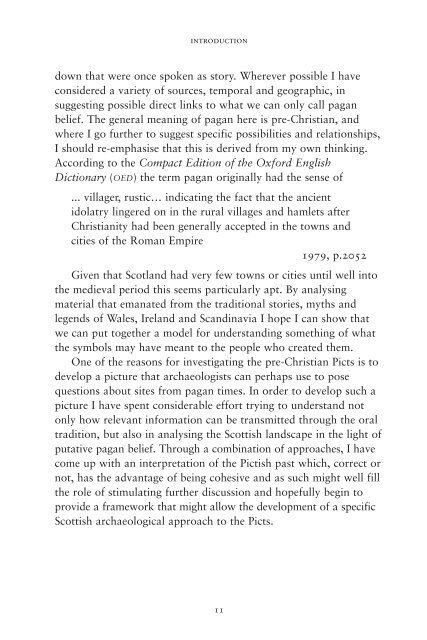Pagan Symbols of the Picts by Stuart McHardy sampler
Stuart McHardy examines the Pictish symbols which have been discovered on various items across Scotland. The book sets out a cohesive interpretation of the Pictish past, using a variety of both temporal and geographical sources. This interpretation serves as a backdrop for his analysis of the symbols themselves, providing a context for his suggestion that there was an underlying series of ideas and beliefs behind the creation of the symbols.
Stuart McHardy examines the Pictish symbols which have been discovered on various items across Scotland. The book sets out a cohesive interpretation of the Pictish past, using a variety of both temporal and geographical sources. This interpretation serves as a backdrop for his analysis of the symbols themselves, providing a context for his suggestion that there was an underlying series of ideas and beliefs behind the creation of the symbols.
You also want an ePaper? Increase the reach of your titles
YUMPU automatically turns print PDFs into web optimized ePapers that Google loves.
introduction<br />
down that were once spoken as story. Wherever possible I have<br />
considered a variety <strong>of</strong> sources, temporal and geographic, in<br />
suggesting possible direct links to what we can only call pagan<br />
belief. The general meaning <strong>of</strong> pagan here is pre-Christian, and<br />
where I go fur<strong>the</strong>r to suggest specific possibilities and relationships,<br />
I should re-emphasise that this is derived from my own thinking.<br />
According to <strong>the</strong> Compact Edition <strong>of</strong> <strong>the</strong> Oxford English<br />
Dictionary (OED) <strong>the</strong> term pagan originally had <strong>the</strong> sense <strong>of</strong><br />
... villager, rustic… indicating <strong>the</strong> fact that <strong>the</strong> ancient<br />
idolatry lingered on in <strong>the</strong> rural villages and hamlets after<br />
Christianity had been generally accepted in <strong>the</strong> towns and<br />
cities <strong>of</strong> <strong>the</strong> Roman Empire<br />
1979, p.2052<br />
Given that Scotland had very few towns or cities until well into<br />
<strong>the</strong> medieval period this seems particularly apt. By analysing<br />
material that emanated from <strong>the</strong> traditional stories, myths and<br />
legends <strong>of</strong> Wales, Ireland and Scandinavia I hope I can show that<br />
we can put toge<strong>the</strong>r a model for understanding something <strong>of</strong> what<br />
<strong>the</strong> symbols may have meant to <strong>the</strong> people who created <strong>the</strong>m.<br />
One <strong>of</strong> <strong>the</strong> reasons for investigating <strong>the</strong> pre-Christian <strong>Picts</strong> is to<br />
develop a picture that archaeologists can perhaps use to pose<br />
questions about sites from pagan times. In order to develop such a<br />
picture I have spent considerable effort trying to understand not<br />
only how relevant information can be transmitted through <strong>the</strong> oral<br />
tradition, but also in analysing <strong>the</strong> Scottish landscape in <strong>the</strong> light <strong>of</strong><br />
putative pagan belief. Through a combination <strong>of</strong> approaches, I have<br />
come up with an interpretation <strong>of</strong> <strong>the</strong> Pictish past which, correct or<br />
not, has <strong>the</strong> advantage <strong>of</strong> being cohesive and as such might well fill<br />
<strong>the</strong> role <strong>of</strong> stimulating fur<strong>the</strong>r discussion and hopefully begin to<br />
provide a framework that might allow <strong>the</strong> development <strong>of</strong> a speci fic<br />
Scottish archaeological approach to <strong>the</strong> <strong>Picts</strong>.<br />
11


















